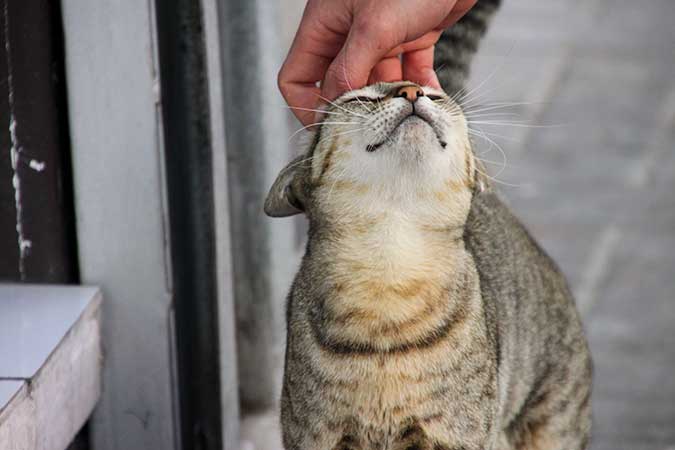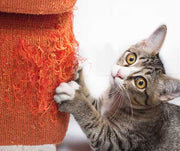How to Help Stray Cats

Have you ever seen a stray cat while you're out and about and wondered what you should do? It can be hard to know if you should approach the cat or leave it alone, especially if they are not wearing a collar and you're not sure if it's someone's pet. Keep reading as we cover how to properly handle and interact with stray cats as well as ways you can make a difference.
STRAY VS. FERAL CATS
You may have heard the term "stray" and "feral" used interchangeably, but there is a difference between stray and feral cats. Stray cats are felines who have been socialized and are comfortable around people. Feral cats, on the other hand, are not used to interacting with humans and are used to living on their own in the outdoors.
How are you able to tell if a cat is stray or feral? It can be hard to tell simply by observing a cat, so it may depend on how the cat is acting around you. Stray cats may approach people or people's houses, meow, make eye contact, and will overall act more friendly towards you than a feral cat will. Feral cats will likely keep their distance or hide from people.
PROBLEMS WITH STRAY AND FERAL CATS
One big problem with stray and feral cats is overpopulation. There are between 60 and 100 million feral cats in the U.S. alone, according to the People for the Ethical Treatment of Animals. Many times, feral cats are the result of abandoned or lost cats who have kittens that are not raised around people. Because female cats can start getting pregnant as young as 16 weeks old, they can easily give birth to multiple litters in their lifetime.
Stray and feral cats also don't live in ideal conditions. They usually reside in abandoned buildings and lots and eat from trash cans. This puts them at risk of various infections and diseases. Poor living conditions and diet, along with females experiencing multiple pregnancies, make the lifespan very short for stray and feral cats – usually only around two or three years.

WHY AND HOW YOU SHOULD HELP
You may thing that stray and feral cats aren't a big problem in your area. However, it is something that can get out of control very quickly if you aren't aware of the best practices for preventing cats from overrunning your area. There are several things you can do:
- TNR: What is TNR? This stands for "Trap-Neuter-Return" and is a method endorsed by the Humane Society as well as the ASPCA. How does this work? Stray or feral cats are humanely and carefully trapped and brought to a vet where they are sterilized and vaccinated. They're looked after as they recover and then brought back to their familiar environment. This not only helps with the issue of overpopulation, but it prevents health problems and helps them live better lives.
- Protecting Cats and Wildlife: It's important to not only keep cats in mind but also the surrounding wildlife in your area. If you have a pet cat, be sure it is spayed or neutered and up-to-date on all of its vaccinations, especially if your let it outside where it may have run-ins with other cats or animals. This will not only keep your pet safe but will also help eliminate the spread of disease to other animals. If you have some stray cats in your community, you may be able to have them sprayed or neutered and vaccinated for free from some animal welfare organizations. If you're feeding community cats, be sure you keep the area yor're feeding them in clean and pick up any scraps before it gets dark. This will eliminate nocturnal wildlife from being attracted to your space, which could result in them attacking the cats… or the other way around!
- Keeping Peace with your Neighbors: Stray cats can sometimes cause conflict among neighbors, especially if they're getting into on person's garden or attacking another person's birdhouse. Instead of blaming each other, it's a good idea to work together to find ways to keep outdoor cats out of the spaces in your yard that you don't want to be damaged. There are a variety of things you can use, such as motion-activated sprinklers, ultrasonic devices, and cat-proof fences.
OTHER WAYS TO HELP

- If you notice a stray cat with a collar and tags, be sure you contact the owner. If you don't hear back or the cat has a collar but no ID tag, list the cat in your local "found" lists and share it to social media groups. You should also check to see if the cat is microchipped. Your local animal shelter or vet may be able to help with this.
- If you are passionate about caring for stray cats, you can become a community cat caretaker or volunteer at vet events for community cats. Caring for a community or a cat colony is a big responsibility, so be sure you contact your local vet or animal welfare group for more information on how to get started.
- Last, of all, you can always donate to various organizations that work to provide health care for stray and feral cats.
Ready to make a difference in the lives of the strays you see around your home? Continue to education yourself and consider finding ways to volunteer your time to care for them!
Sources:
- https://www.humanesociety.org/resources/how-individuals-can-help-community-cats
- https://www.petfinder.com/helping-pets/feral-cats/helping-stray-abandoned-kittens/
- https://pets.webmd.com/cats/helping-stray-and-feral-cats#1
- https://www.humanesociety.org/news/keeping-neighborhood-cats-safe
- https://www.alleycat.org/resources/feral-and-stray-cats-an-important-difference/
- https://www.humanesociety.org/sites/default/files/docs/community-cats-wildlife.pdf
- https://www.neighborhoodcats.org/how-to-tnr/colony-care/keeping-cats-out-of-gardens-and-yards-2
Previous article

Next article

Related posts
View all-

Wet Vs. Dry Cat Food: Which is Better?
As a caring cat owner, you always want the best for your furry friend, especially with their food. You typically have two choices: dry cat food in a bag or canned wet food. Whether you've just brought home a new kitty or are looking to transition to a new food, the decision process can be overwhelming, and understanding the impact of each on your cat's diet is essential. Read Article -

Celebrate National Pet Week: Fun Ideas to Celebrate with Your Pet
National Pet Week is right around the corner, so it's time to plan how you're going to celebrate! While we're sure you celebrate your pet all day every day... Read Article -

5 Simple Tips to Make Sure Your Cat Drinks Enough Water
Ensuring your cat stays hydrated is important, but it can be challenging since many cats don't drink enough water. Dehydration can lead to kidney disease and other health issues. Fortunately, you can encourage your cat to drink more with a few simple changes. Read Article



